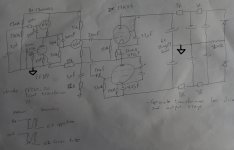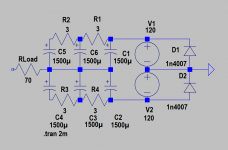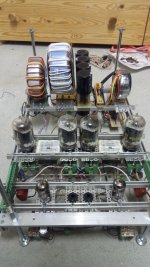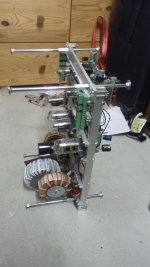Dear all,
For the line arrays in my living room I wanted to try some OTLs, first for the mid highs, later for the woofers. The mid/highs consist of 12 planar drivers, for a total of 72R and deafening SPL at 5W…
I worked on a circlotron, shown in another thread https://www.diyaudio.com/community/threads/nfb-in-circlotron-more-nfb-higher-thd-why.389662/. It worked, but I want to use power transformers at hand, so I am now trying the Futterman, as shown in the schematic. Due to feedback phase I decided to use the original Futterman (not the technics variant with inverted connections), as simulations elsewhere have shown that both have similar overall THD and output impedance. (The Technics has more “local feedback” because of the output tubes operating as cathode followers, but as such less gain and therefore less GNFB.)
The output tubes are the 17KV6. These can do cathode peak currents of almost 1A. I also have a lot of 22JF6s, which are electrically quite similar to the 17KV6. I have a lot of both, so will stick with these for the 4 channels I need (for the bass, 56R impedance and requiring more power, I will use 2 22JF6 in parallel).
The amplifier is simple: a gyrator loaded EF184, signal is level shifted to about 1/4B+ and fed into the concertina, which then couples to the output tubes. I use auto-bias for the moment, with about 90mA on each output tube. As part of the crossover for mid/highs I need a capacitor anyway (3uF into the 72R load), so that also acts as protection against output DC offset.
To filter the G2 I used this PT https://www.mouser.ch/ProductDetail/553-FP230-50 after learning the trick from Helmut Otte https://audioxpress.com/article/The-SPP-Amplifier
As drawn, it works on the bench. THD<0,1% at 1W output (circa 8-9VRMS), IIRC about 10W at the onset of clipping. The only problem is it does motorboat sometimes. I recognize this because I see the nice 1kHz sine wave on the scope bouncing up and down at say 3 Hz.
So, the question, by looking at the schematic, can anyone suggest what could be going on there?
Many thanks and best regards,
Erik
For the line arrays in my living room I wanted to try some OTLs, first for the mid highs, later for the woofers. The mid/highs consist of 12 planar drivers, for a total of 72R and deafening SPL at 5W…
I worked on a circlotron, shown in another thread https://www.diyaudio.com/community/threads/nfb-in-circlotron-more-nfb-higher-thd-why.389662/. It worked, but I want to use power transformers at hand, so I am now trying the Futterman, as shown in the schematic. Due to feedback phase I decided to use the original Futterman (not the technics variant with inverted connections), as simulations elsewhere have shown that both have similar overall THD and output impedance. (The Technics has more “local feedback” because of the output tubes operating as cathode followers, but as such less gain and therefore less GNFB.)
The output tubes are the 17KV6. These can do cathode peak currents of almost 1A. I also have a lot of 22JF6s, which are electrically quite similar to the 17KV6. I have a lot of both, so will stick with these for the 4 channels I need (for the bass, 56R impedance and requiring more power, I will use 2 22JF6 in parallel).
The amplifier is simple: a gyrator loaded EF184, signal is level shifted to about 1/4B+ and fed into the concertina, which then couples to the output tubes. I use auto-bias for the moment, with about 90mA on each output tube. As part of the crossover for mid/highs I need a capacitor anyway (3uF into the 72R load), so that also acts as protection against output DC offset.
To filter the G2 I used this PT https://www.mouser.ch/ProductDetail/553-FP230-50 after learning the trick from Helmut Otte https://audioxpress.com/article/The-SPP-Amplifier
As drawn, it works on the bench. THD<0,1% at 1W output (circa 8-9VRMS), IIRC about 10W at the onset of clipping. The only problem is it does motorboat sometimes. I recognize this because I see the nice 1kHz sine wave on the scope bouncing up and down at say 3 Hz.
So, the question, by looking at the schematic, can anyone suggest what could be going on there?
Many thanks and best regards,
Erik
Attachments
Last edited:
thanks for the reply. Indeed forgot to add the gnd symbol to the PSU, so it is not floating (I added the gnd to the picture in 1st post).
It is a doubler PS, fed from 120VAC secondary.
Until now I have not connected it to an actual speaker, I just saw the 1kHz test sine bouncing up and down on the scope (The scope is analog, vertical adjustment to show the 1kHz from the signal generator), I think it is motorboating because the sine bounces up and down a couple times per second.
It is a doubler PS, fed from 120VAC secondary.
Until now I have not connected it to an actual speaker, I just saw the 1kHz test sine bouncing up and down on the scope (The scope is analog, vertical adjustment to show the 1kHz from the signal generator), I think it is motorboating because the sine bounces up and down a couple times per second.
Last edited:
I think the 3mu, 22 ohm combination shortens the nfb. That might be the cause.
Besides I would add a few grid stoppers because you don't use them anywhere. In my experience deflection tubes like the pl519 must be used with Rg2's of about 220 ohms to prevent oscillation. EF 184 same story.
Apart from this why not connect the output tubes as triodes as you need very little power?
Besides I would add a few grid stoppers because you don't use them anywhere. In my experience deflection tubes like the pl519 must be used with Rg2's of about 220 ohms to prevent oscillation. EF 184 same story.
Apart from this why not connect the output tubes as triodes as you need very little power?
Thanks for the replies and thoughts! There are grid stoppers on all tubes, buy I added 820R G2 stoppers on the EF184 today.
I started testing today and noticed that the amp starts stable, and when increasing volume it will reach clipping, and from there on it motorboats, even when turning down the volume. I added More decoupling to the EF184 G2s, and the G2 stoppers. Increasing the volume beyond clipping started the motorboating again, but reducing the volume the amp went stable again. Then I took out the 100nF to the concertina, and no motorboating anymore (but a little more distortion...) Decreased those to 33nF, and motorboating was back. I think I will leave these caps for the moment, the overall distortion figures are very good anyway.
I am getting about 10W just before clipping. At 1W it has 0,08% THD.
Regarding triode operation - maybe?! Is not that hard to test it out.
I started testing today and noticed that the amp starts stable, and when increasing volume it will reach clipping, and from there on it motorboats, even when turning down the volume. I added More decoupling to the EF184 G2s, and the G2 stoppers. Increasing the volume beyond clipping started the motorboating again, but reducing the volume the amp went stable again. Then I took out the 100nF to the concertina, and no motorboating anymore (but a little more distortion...) Decreased those to 33nF, and motorboating was back. I think I will leave these caps for the moment, the overall distortion figures are very good anyway.
I am getting about 10W just before clipping. At 1W it has 0,08% THD.
Regarding triode operation - maybe?! Is not that hard to test it out.
I made a cct yet to build using a similar layout
12ax7 > fet concertina with feedback > 6922 > 2sc5200 > speaker
Should be good for 25w with 40v rails.
12ax7 > fet concertina with feedback > 6922 > 2sc5200 > speaker
Should be good for 25w with 40v rails.
Let me add some pictures to this.
I have a cabinet that has place for two of these chassis (biamped speakers), the DAC and the crossover. This cabinet is well closed, so I can live with this open construction. Two chassis on top of each other and some noctua fans that pull air through the open construction.
The 17KV6's are oddball tubes that I bought in a dollar sale about 15 years ago. They need the hard to find compactron 9 pin socket. If I were to do this again, from 0 and living in Switzerland, I would probably use 6P45C (the USRR equivalent for the EL519), which can be found for a good price and with the more common magnoval socket. For power transformers, I would get some big VPT230 for the bipolar power supply, a small VPT230 for the driver PS, and something from the same line for heaters, from mouser or digikey.
I have a cabinet that has place for two of these chassis (biamped speakers), the DAC and the crossover. This cabinet is well closed, so I can live with this open construction. Two chassis on top of each other and some noctua fans that pull air through the open construction.
The 17KV6's are oddball tubes that I bought in a dollar sale about 15 years ago. They need the hard to find compactron 9 pin socket. If I were to do this again, from 0 and living in Switzerland, I would probably use 6P45C (the USRR equivalent for the EL519), which can be found for a good price and with the more common magnoval socket. For power transformers, I would get some big VPT230 for the bipolar power supply, a small VPT230 for the driver PS, and something from the same line for heaters, from mouser or digikey.
Attachments
- Home
- Amplifiers
- Tubes / Valves
- Beam power pentode OTL




